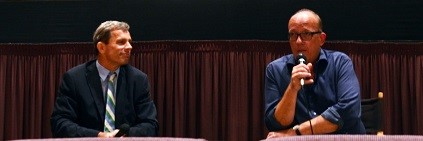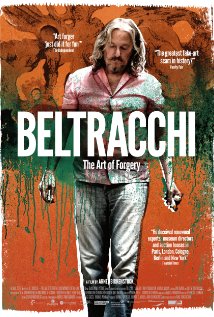Beltracchi: The Art of Forgery tells the appealing story of a renowned German art forger who for four decades painted canvases in the style of famous artists that he put on the market, fooling many of the top "art experts" in the business. The forger, Wolfgang Beltracchi, comes across as an unapologetic rogue who, despite finally being caught in 2010 and sentenced to a short term in prison, says he has "no regrets."
The film opens with a string of commentary about Beltracchi, with one art dealer who had been conned saying the 6 year sentence Beltracchi received was too lenient - "I would have preferred sharia law." An art critic said Beltracchi's ability to keep fooling numerous experts with his fakes was like watching "a bad cowboy movie, where the cowboy keeps shooting one sheriff after another."
Beltracchi faked work by famous artists including Max Ernst, Fernand Léger and Heinrich Campendonk. With meticulous research, Beltracchi would find a "hole" in their catalogue - a period when there were no known paintings available. He would then compose a painting in their signature style from that time frame, of a subject they might conceivably have chosen. As he hangs up a new fake Max Ernst painting, he says that Ernst "would not have found this funny... he would have said 'lock him up'." The fake 1927 Max Ernst oil painting Beltracchi painted called La Forêt (2) was lent to the Max Ernst Museum and eventually sold to a collector for $7 million.
Beltracchi, who does not suffer from a small ego, feigns to be hurt at his lack of recognition: "I'm in all these museums and no one knows it's me!" When asked if he could copy any artist, Beltracchi grandiosely says, "yes... I could do a Leonardo, no difficulty..." The film's director Arne Birkenstock described his subject in a Q&A after the screening. "The personality of Beltracchi is the kind art lovers hate, and filmmakers love," said Birkenstock. He has "this ambivalent character, a dark and light side" where he is both "charming" and "ruthless."
The whole forging process is detailed in the film. It starts with Beltracchi and his wife Helene perusing flea markets - they hunt for old, cheap oil paintings whose canvases and frames are then used to produce forgeries. Beltracchi is shown analyzing the quality of frames and the stamps on the back of the canvases. At their home, Beltracchi meticulously scrapes off the original picture, paints his fake, dries it in a handmade warming cupboard, and irons the back of the canvas. As a finishing touch, he sprinkles dust into the frame. The chief investigating cop in his case said it was hard to build up evidence against Beltracchi "because of the quality of his forgeries."
In a recurring theme, the film makes the case that it was also hard to initially discover the forgeries because in the high-priced art market, neither the buyer, the seller, the auction house nor the consulting expert have any motivation to declare a work a fake - as that would mean nobody making money on the sale. "It is easier to sell a painting for half a million than for 10,000," said Beltracchi in the film. "No one thinks it is a fake anymore."

Terry McCarthy and director Arne Birkenstock
Beltracchi and his wife came up with masterfully elaborate schemes. In one scene, to fake the history of their family's art collection, Helene dresses up in clothes from her grandmother's era and poses in front of a series of paintings - most are genuine but included is one fake Fernand Léger by Beltracchi. Using an old-fashioned camera on film printed in sepia tint, the picture taken is then used to effectively provide to the art world retroactive provenance of a painting Beltracchi faked many years later.
As their lies continued to grow, so did their fortune. Beltracchi, his wife and their two children enjoyed a life of luxury including multiple lavish homes and vacations. "He had a good life," said Birkenstock. "You can tell he's not really regretting anything." Ultimately the truth caught up with him. His mistake was using a modern Titanium White paint in his forgery of a Campendock painting that he dated 1914, way before the titanium additive was ever used.
Beltracchi's scams shocked the art world. "We still don't know how many paintings he forged," said the prosecutor in his case. The police identified 50 forgeries, but Beltracchi cannot stop himself from claiming he did some 300 paintings and drawings between 1970 and 2010. "Many of his forgeries disappeared," said Birkenstock.
Beltracchi and Helene, who have since been released from jail, were allowed to serve their sentences in an open prison - where they could go to work together during the day but would return to their own prison cells at night. If she had known their fate, Helene said she "never would have done it." In a poignant scene at the end of the film, Beltracchi is asked by an art historian about what he will do now - sell his own paintings or sell "painted-in-the-style-of" Max Ernst by Beltracchi? "You can actually see more in his facial expressions than in the words he speaks out," said Birkenstock as Beltracchi realizes his own work is nothing close to the marketability of his fakes.
Birkenstock has looked up Beltracchi's new work shown in galleries. "They were selling mainly paintings in the style of others," said Birkenstock, "signed now with the right name Beltracchi."

